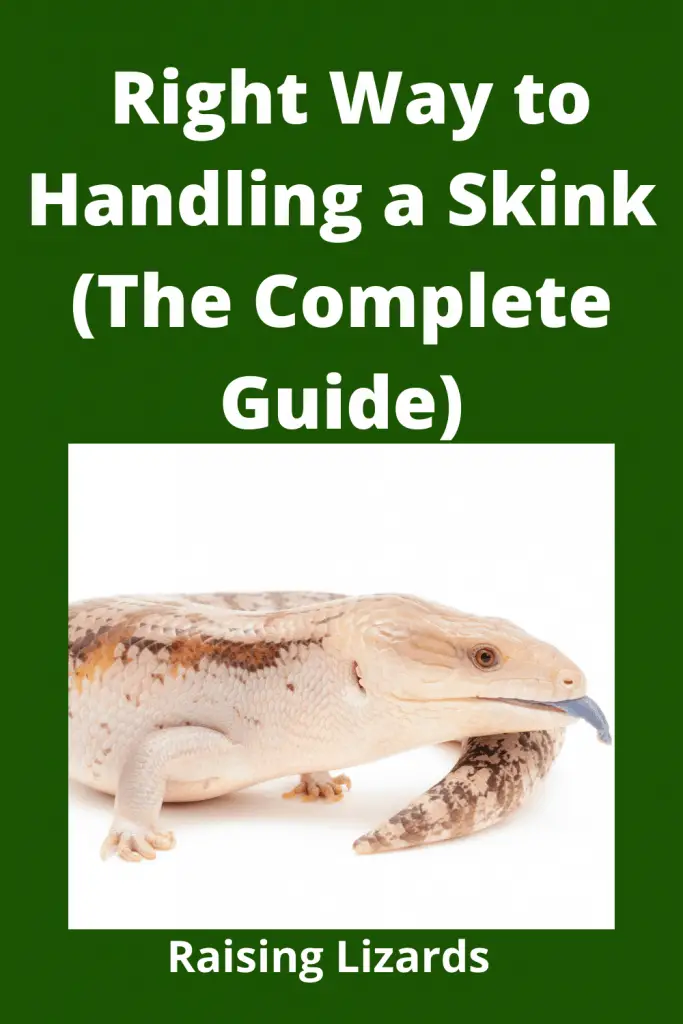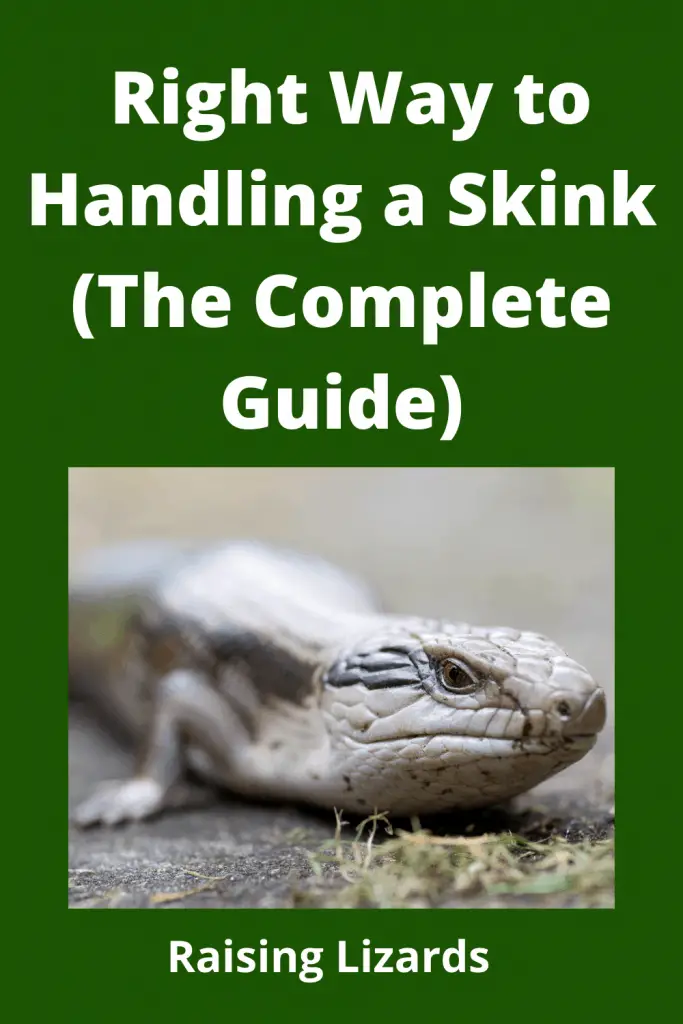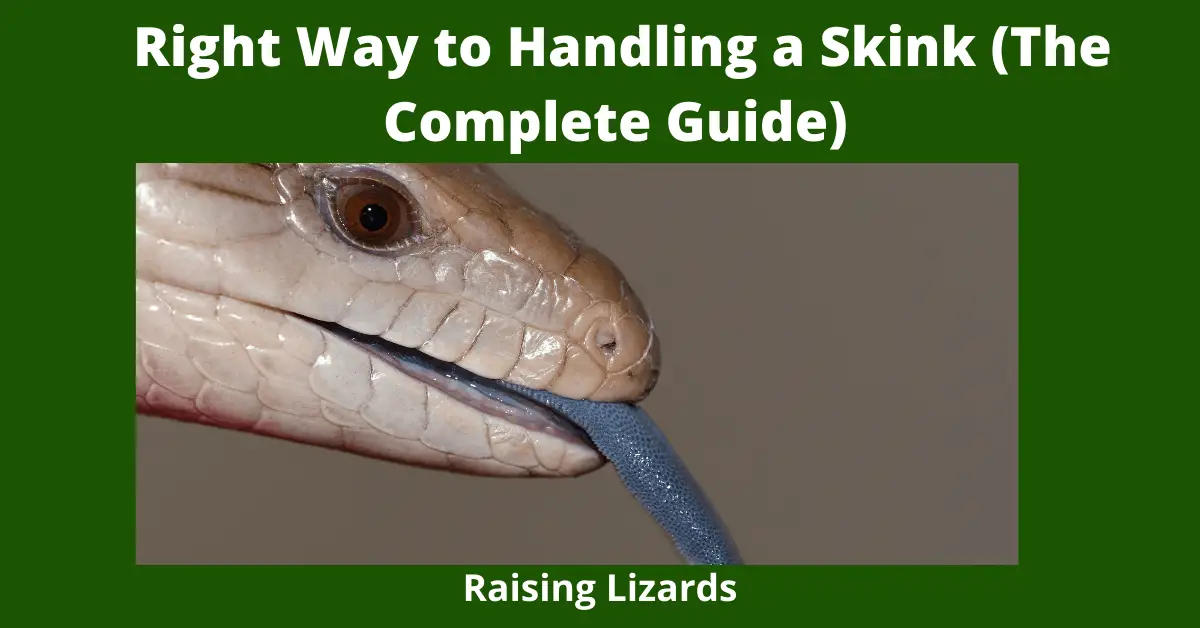Handling a Skink Pro Tips
Any new reptile, including new skink, should be allowed to acclimate for a couple of days. It shouldn’t be handled until it’s comfortable in its new environment. When new skink starts eating regularly, then handling can begin. First handling sessions should be 10 minutes or less per session. This will be done a few times every day during the acclimation process. make confirm to carry your skink is near the ground or over a bed, sofa, etc., just in case he gets nervous. Lift your skink by gently encircling its body near the forelegs together with your fingers. Support its body together with your blank check.
Skinks are often very trusting, but they can’t hold on also as other lizards, therefore always take care to support their bodies. Since skinks cannot regulate their blood heat, don’t keep them outside of their enclosure for long periods of your time. Do not grasp your skink from the tail because it can break off and it doesn’t regenerate well again.
Proper Handling Techniques
There are some ways to handle and hold skink, but the foremost important thing to recollect is to stay the animal’s entire body supported. Especially their hindquarters.
Proper handling is also important to show your children, otherwise, when held, you’ll have a really finicky and panicked skink. If their backside isn’t supported, they go to fling their tails around wildly because they don’t feel secure and feel as if they’re going to fall. If you have ever heard of blue tongues peeing on you, this is often the time they’ll roll in the hay.
However, when handled in a correct and responsible manner, you’ll haven’t any problems. Simply lay your skink across your underarm, with great care his nose touches your bicep, then support his backside together with your palm. This creates complete security and support for his entire body. You’ll use your right or left arm, whichever you’re most comfortable with.
Always remember that these aren’t little geckos or anoles, so it is vital that you simply don’t drop your animal. you’ll likely escape with an accidental drop with a small lizard or maybe an extended snake, but a skink would fall sort of brick. Also, never plan to hold your Skink the wrong way up. He will struggle to his maximum strength and bones can begin of place and even break.
Hand washing
As an honest rule of thumb, it is better to wash your hands before and after handling your skink or any other reptile (hand sanitizer works well during a pinch) both to guard your animal against foreign bacteria and also yourself. Zoonosis is extremely rare, however, but hand washing remains recommended.
Tips for handling a skink
- Always approach the skink from lower and from the side.
- If you approach them from the backside, they will get scared and they will think that some predator jumping down on them.
- The best way to pick up the skink is by cupping your hand under the bellies, this can be done with the help of your index finger up to their neck between their forelegs, their rear end resting on your wrist or arm.
- Skinks don’t have the legs to grip on as well as further lizards, so always take of them.
- Skink tail can hurt if it whips, it should be taken away from the eyes of the small children, this can be done by gently guiding it away from the small kids.
- Claws of skinks are very lethal, and it can hurt small children as they can easily break the skins due to its pointing end. It makes pet owners feel scared and upset due to claw injury so it should always be trimmed without affecting their ability to climb.
- The child can throw the skink down or across the room out of anger and fear or it can even happen due to surprise at the unexpected sensation. We should watch and talk to them about children should not be bothered due to the clawed skinks.
- Educating the child about the claws and telling them the skink is not trying to hurt you, helps the child accept it.
- Touching the cold skink may feel like the skink is wet or slimy, initially, it can prick of little claws feel more like it hurts than what it feels like: a tickle.
- When the skinks are trying to climb a person’s head it means that they are nervous or trying to get control of a person by climbing to the dominant position.
- Do not let the skinks stay on the top of the heads.
- Cautiously remove the skin from the head, carefully remove the claws from the strands of hair and place the skink safely on your hand again.
- When moving skink to an individual, particularly a kid, be certain to put the hand over the foot is most likely to reach up towards the face.
- Tell the individual what you are doing so she won’t attempt to move in the opposite direction from your hand, accordingly, presenting her face to the claws.
- Skinks can Play Dead
- If the skink begins to whip and roll, don’t control it by holding it tighter. Let it move around in your grasp, holding it marginally away from your body about chest high, and get it far from other people’s faces.
- Hold the skink straight up in the air, if essential, until it quiets down. If a skink is whipping around in someone else’s hands, you can take it from them and quiet it down.

Do’s during handling of skink
• Never handle the skink when it is not expecting it
• Never disturb the sleeping skink and do not try to pick it up.
• Make sure the skink is aware when you are about to pick it up.
• Always support the bodyweight of skink when holding it
• Never turn the skink upside down this will lead to stress.
• Abrupt movements should be avoided while handling a skink.
Body Language
When the skink is sorting short and huffing it means that the skink is annoyed by something. Wagging of the tail indicates the skink is irritated or in anger. Long hisses and body tilt meaning the skink is in aggressive mode and showing mouth and tongue is a defence reflex which means the person should back off.

Skink Interaction
Skink has tiny little legs and feet, in order that they don’t go anywhere fast (although they’re capable of unusual speeds when in pursuit of live prey), and that they have very personable, almost human eyes. Once you approach them, you’ll see them watching you. You can’t make eye contact with any snake or gecko.
You’ll make actual eye contact with a skink, which to me can develop a bond between a skink and its owner. If you are looking to race your skinks, then this is often probably not the lizard for you. They’re, however, very curious. If they are in the right mood, they like to explore. found out some newspapers, blankets, empty cereal boxes, etc.
They are going to search in and out, and in every nook and cranny with their Big Blue tongue going ever faster. It is a blast to watch! After a short time, you’ll just find him asleep.
Some keepers believe that handling should be kept to a minimum as reptiles only “tolerate” handling instead of actually enjoying or benefitting from it, at an equivalent time, however, most still believe that the skink will enjoy an occasional romp outdoors within the sun.
Remember that skinks aren’t domesticated sort of a dog or cat. They’re wild animals, But if a reptile does enjoy being out and about, it’s unsure that that differs from anything whether it’s walking within the grass, walking on your lap, walking on the ground, or doing anything outside its regular cage.
They only live their life and take things because it comes, and a captive bred bluey’s curiosity often gets the simplest of them (sudden captivity would essentially be disorientation for a wild-caught pet).
Once they do not feel threatened, then they’re interested in everything, the sky, the grass, different foods & various sounds. That curiosity is satisfied which is clear in their often obvious change in behavior when interacted with, and whether that be enjoying the sun outdoors, or being petted on the top, it’s stimulation and interaction that’s beneficial in my book. For most, handling may be a big part of enjoying your skink.
Conclusion
Skinks need to be handled carefully. They can become frightened and unintentionally scratch with their claws.
Skinks Prices
| Species of Skinks | Lifespan | Largest Length | Price | |
|---|---|---|---|---|
| Blue Tongue Skinks | 20 Years | 24" | $199- $499 | |
| Schneider's Skinks | 20 Years | 18" | $ 60 | |
| Blue Tailed Skinks | 8 - 10 Years | 5" - 8.5" | $ 14.99 | |
| Red-Eyed Crocodile Skinks | 12 Years | 8" - 10" | $ 199 | |
| Monkey Tailed Skinks | 20 Years | 32" | $ 799 | |
Fire SkiRed-Eyed Crocodile Skinks | 12 Years | 8" - 10" | $ 188 - $ 279 | |
Lifespan
Size
Price
Lizard Habitats and Facts
| Lizard Type | Foods | Adult Size | Vivarium Type | Eggs | Temperament | Country Origin | Price |
|---|---|---|---|---|---|---|---|
| Ameiva | Insects | 20 " | Tropical Woodland | 2-8 | Aggressive | Central, South America | $ 49.99 |
| Alligator Lizard | Insects | 20" | Semi- Aquatic | 6-12 | Aggressive | North America | $ 18 |
| Asian Water Dragons | Carnivorous | 40" | Tropical Woodlands | 8-16 | Aggressive | Asia | $ 18 - $ 80 |
| Panther Chameleon | Insects | 12" | Tropical Woodlands | 30-50 | Aggressive | Madagascar | $ 150 - $ 600 |
| Jacksons Chameleon | Insects | 14" | Temperate Woodlands | Up to 30 Live Young | Aggressive | East Africa | $ 75 - $175 |
| Giant Day Gecko | Insects | 10" | Tropical Woodlands | 2 | Aggressive | Madagascar | $ 79.99 |
| Leopard Gecko | Insects | 10" | Desert | 2 | Aggressive | Asia, India | $ 30 - $ 45 |
| Tokay Gecko | Insects | 14" | Tropical Woodland | 2 | Aggressive | Southeast Asia, New Guinea | $ 39.99 |
| Blu Tongue Skink | Vegetarian | 20" | Savannah | 6-25 | Aggressive | New Guinea, Australia | $ 150 - $ 649 |
| Common Walled Lizard | Insects | 8" | Savannah | 3-8 | Aggressive | Central Europe | $ 460 - $ 600 |
| Green Lizard | Insects | 16" | Savannah | 6-20 | Aggressive | Europe, Southern Asia | ? |
| Green Iguana | Vegetarian | 60" | Tropical Woodland | 20-40 | Aggressive | Central, South America | $ 39 - $ 55 |
| Desert Iguana | Vegetarian | 15" | Desert | 3-10 | Aggressive | USA, Mexico | $ 34.99 |
| Six Lined Racerunner | Insects | 11" | Savannah | 4-6 | Aggressive | USA | $ 29.99 |
| Chinese Crocodile Lizard | Carnivorous | 12" | Semi- Aquatic | 2-12 Live Young | Aggressive | China | $ 1200 |
| Collared Lizard | Insects | 14" | Desert | 4-24 Eggs | Aggressive | USA, Mexico | $ 53.99 |
| Western Fence Lizard | Insects | 9" | Savannah | 6-13 | Aggressive | USA | $ 19.99 |
| Chuckwalla | Vegetarian | 18" | Desert | 6-13 eggs | Aggressive | Mexico | $ 88.99 |
| Green Anole | Insects | 9" | Tropical Woodland | 2 | Aggressive | Southern USA | $ 10.00 |
| Brown Anole | Insects | 8" | Tropical Woodland | 2 Eggs | Aggressive | Caribbean, Central America | $ 3.99 - $ 7.99 |
| Knight Anole | Insects | 22" | Tropical Woodland | 1-2 | Aggressive | Cuba | $ 39.99 |
| Nile Monitor | Carnivorous | 79" | Savannah | 10-60 | Aggressive | Egypt | $ 69.99 |
| Bosc's Monitor | Carnivorous | 69" | Savannah | 10-50 | Aggressive | Central Africa | $ 100 - $ 150 |
| Bearded Dragon | Insects | 20" | Desert | 15-30 | Social | Australia | $ 60 - $ 400 |
| Agama | Insects | 16" | Savannah | 10-20 | Aggressive | North Africa | $ 24.99 |
| Five Lined Skink | Insects | 9" | Temperate Woodland | 15 | Aggressive | Africa | $ 10 |
| Red Tailed Rock Lizard | Insects | 8" | Savannah | 2-4 | Aggressive | South Africa | ? |
Food
Size
Vivarium Type
Country Origin
Price
Eggs
Temperament
Approx Cost



